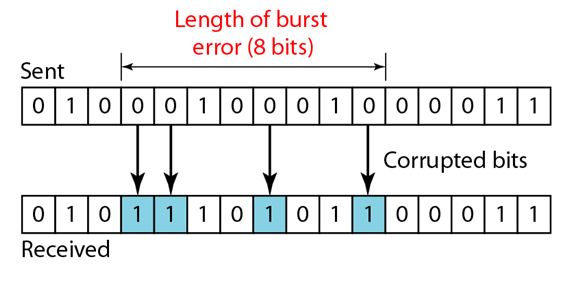Types of Errors:
Networks must be able to transfer data from one device to another with acceptable accuracy. Any time data are transmitted from one node to the next, they can become corrupted in passage. Many factors can alter one or more bits of a message. Some applications require a mechanism for detecting and correcting errors.
Whenever bits flow from one point to another, they are subject to unpredictable changes because of interference. This interference can change the shape of the signal. In a single-bit error, a 0 is changed to a 1 or a 1 to a 0. In a burst error, multiple bits are changed.
Single-Bit Error
The term single-bit error means that only 1 bit of a given data unit (such as a byte, character, or packet) is changed from 1 to 0 or from 0 to 1.
Important Concepts in Error Detection and Correction
Block Coding Techniques
Hamming Distance
Simple Parity Check Code
The following figure shows the effect of a single-bit error on a data unit. To understand the impact of the change, imagine that each group of 8 bits is an ASCII character with a 0 bit added to the left. In the figure 00000010 (ASCII STX) was sent, meaning start of text, but 00001010 (ASCII LF) was received, meaning line feed.
Burst Error:
The term burst error means that 2 or more bits in the data unit have changed from 1 to 0 or from 0 to 1.
The following figure shows the effect of a burst error on a data unit. In this case, 0100010001000011 was sent, but 0101110101100011 was received. Note that a burst error does not necessarily mean that the errors occur in consecutive bits. The length of the burst is measured from the first corrupted bit to the last corrupted bit. Some bits in between may not have been corrupted.
Hamming Codes
Cyclic Codes
Checksum
Back to DCN Questions and Answers



